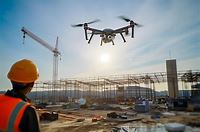The Role of Drones in Construction: Improving Efficiency and Safety on Job Sites
The construction industry is witnessing a technological revolution with the adoption of drones. These advanced unmanned aerial vehicles (UAVs) are redefining project planning, monitoring, and execution. By capturing high-resolution images and videos from the sky, drones provide construction teams with detailed visual insights, leading to smarter decisions and streamlined operations. Their ability to improve both efficiency and safety makes them invaluable on job sites.
One of the most transformative uses of drones in construction is for surveying and mapping. Traditional surveys required extensive time and manpower, often causing delays in project timelines. In contrast, drones can rapidly capture data to generate precise topographic maps, enabling engineers and architects to access real-time information. This swift data collection supports faster project starts and better resource allocation.
Additionally, drones are essential for tracking project progress. By regularly capturing aerial footage, stakeholders can visualize development without needing to physically visit the site. This continuous monitoring helps generate detailed progress reports, identify potential issues, and ensure adherence to project designs. The drone-captured data can also be used to create 3D models, offering a comprehensive and interactive view of the construction site.
Enhancing job site safety is another crucial benefit of drone technology. Construction sites often have hazardous environments, with risks such as working at heights or near heavy machinery. Drones can inspect challenging areas and assess conditions without putting workers in danger. For instance, drones can be deployed to examine tall structures or monitor hazardous zones, minimizing the need for human involvement in high-risk tasks.
Drones also improve communication and transparency among project stakeholders. High-quality visuals captured by drones can be easily shared with clients, investors, and team members, providing a clear understanding of project progress. This fosters better collaboration and keeps everyone aligned throughout the construction process.
Despite these advantages, challenges remain in the widespread adoption of drones. Companies must navigate regulations, address data security concerns, and train skilled operators. However, as drone technology advances and industry regulations become more streamlined, these challenges are likely to diminish.
In conclusion, drones are transforming the construction landscape by enhancing efficiency, improving safety, and fostering better communication. As technology continues to evolve, their role will only become more significant, making them essential for innovative construction practices.
.png)






Leave a Comment
Your email address will not be published. Required fields are marked *